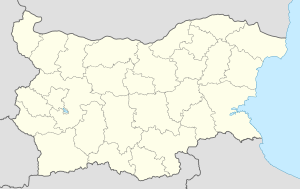Kazanlak
|
Kazanlak, Bulgaria Казанлък |
|
|---|---|

The Center of Kazanlak
|
|
| Nickname(s): The Town of the Roses and the Thracian Kings | |
| Location of Kazanlak on a map of Bulgaria | |
| Coordinates: 42°37′N 25°24′E / 42.617°N 25.400°ECoordinates: 42°37′N 25°24′E / 42.617°N 25.400°E | |
| Country | Bulgaria |
| Province | Stara Zagora |
| Government | |
| • Mayor | Galina Stoyanova |
| Area | |
| • City | 36.067 km2 (13.926 sq mi) |
| Elevation | 407 m (1,335 ft) |
| Population (Feb 2011) | |
| • City | 47,325 |
| • Density | 1,300/km2 (3,400/sq mi) |
| • Metro | 76,849 |
| Time zone | UTC/GMT +02:00 hours |
| Postal code | 6100 |
| Area code(s) | 0431 |
| Website | Official website |
Kazanlak (Bulgarian: Казанлъ̀к, Kazanlǎk, Thracian and Greek Σευθόπολις (Seuthopolis) is a Bulgarian town in Stara Zagora Province, located in the middle of the plain of the same name, at the foot of the Balkan mountain range, at the eastern end of the Rose Valley. It is the administrative centre of the homonymous Kazanlak Municipality.
The town is among the 15 biggest industrial centres in Bulgaria, with a population of 47,325 people as of Feb 2011.
It is the center of rose oil extraction in Bulgaria and the oil-producing rose of Kazanlak is one of the most widely recognizable national symbols.
The oldest settlement in the area of the modern-day city dates back to the Neolithic era (6th-5th millennium BCE). During the 4th-3rd centuries BCE the lands on the upper Tundzha river were within the dominion of the Thracian ruler Seuthes III and took an important place in the historical development of Thrace during the Hellenistic era. The Thracian city of Seuthopolis (Σευθόπολις) was uncovered near Kazanlak and thoroughly studied at the time of the construction of the Koprinka Reservoir. In the 4th century BCE, near the ancient Thracian capital of Seuthopolis and close to the city, a magnificent Thracian tomb was built. Consisting of a vaulted brickwork "beehive" (tholos) tomb, it contains, among other things, painted murals representing a Thracian couple at a ritual funeral feast. The tomb was declared a UNESCO World Heritage Site in 1979.
...
Wikipedia

